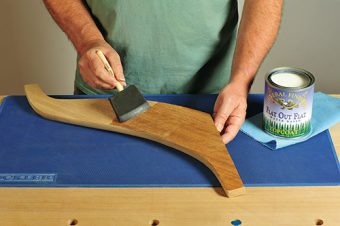Waterborne Wood Finish Basics
Finishes that clean up with water are often referred to as "water-based", which is a little misleading. From a technical standpoint, "waterborne" is a much more fitting term.
In fact, the term "water-based" itself has been a hindrance to the reputation of many finishing products over the years. And understandably so: If a finish were truly "water-based" it would wash off with a wet rag no matter how long you let it dry, and wouldn't be much good for anything. But in reality, water plays only a supporting role in the process that turns waterborne finish from a liquid into a durable protective film.
Understanding how a finish that cleans up in water can can adequately protect a wood surface is easier when you know a little about how the chemical process works. A waterborne finish is composed of minute spheres of resin (most commonly acrylic and polyurethane) suspended in water along with a slow evaporating solvent, such as glycol ether. When you spread a waterborne finish out in the open air, the water begins to evaporate. The solvent, which evaporates slower, stays behind and softens the protective coating on the tiny resin "latexes", causing them to bond into one continuous film. Since the solvent is the active ingredient the curing process, and not the water, the protective coating that results is not affected by moisture, and often has considerable resistance to a variety of other substances.
How Tough is a Waterborne Finish?
Waterborne finishes are much more complicated chemically than most traditional wood finishes, and getting them right in the manufacturing process has taken some time. But in the relatively short period since their introduction, the appearance and durability of waterborne finishes have improved dramatically. Many waterborne finishes on the market today rival their long-trusted oil and lacquer based counterparts in both appearance and durability. Currently, there are waterborne finishes available that are suitable for nearly every wood finishing application.
But what really matters is how well a finish stands up to daily life, and that varies widely, depending on the quality of the finish and conditions it is required to face. Generally, any waterborne finish will fair well in light household use. Most have fairly good scratch resistance, and once cured, are (for practical purposes) impervious to water. But that doesn't hold true for exposure to solvents and heat. Certain solvents can loosen the bond between the resin droplets and damage the finish or cause it to become sticky. Heat can also loosen up and damage a waterborne finish. In tests, not all waterborne finishes stand up equally well to these extremes, and the difference from one brand to the next can be considerable.
Waterborne Finish Application and Appearance
How a finish will stand up to use isn't the only consideration, of course. The finish should be reasonably easy to apply, and most importantly should look good when it dries. There is a wide range in the appearance and ease of application among currently available products, and unfortunately, the failings of a few have generated a couple of common misconceptions. The first says that waterborne finishes are all but impossible to spray on. The truth is, many waterborne finishes spray exceptionally well. In fact, certain waterborne finishes have to be sprayed on for acceptable results.
The second misconception holds that waterborne finishes all have a hazy, bluish appearance when dry, and therefore aren't a good choice for darker colored woods. Here again, it really depends on the finish. In reality, most waterborne finishes dry almost perfectly clear. What's missing, for most woodworkers, is the amber tint that they're used to getting from all oil-based "clear" finishes. In other words, most people have come to associate the rich, amber color that most oil finishes add to the natural color of wood with the "correct" result.
Looked at another way, waterborne finishes actually have an advantage over traditional oil-based finishes: They give you more control over the final appearance of your projects. In some situations - when you want to maintain the color of light colored woods, for example - the best appearance a finish can provide is none at all. In other words, the finish should be perfectly clear, and a waterborne will get you closer than anything else. In other situations, where the familiar amber color of an oil finish is a benefit, you have a couple of options: Most waterborne finishes can be tinted to the desired color.
Choosing a Finish
How do you choose a waterborne finish? The can isn't always the most reliable source of information. Fortunately, there's been enough interest waterbornes in recent years to generate ample debate on the merits of various brands. In the mix you'll find a couple very good independent tests. Based on them, and on what we hear back from our customers, here are a couple of top choices:
Are Waterbornes the Only Finish to Use?
Waterborne wood finishes are a safe, environmentally friendly option for most finishing projects, and offer a number of advantages - they're easy to use, dry super fast, clean-up with water and (most) dry almost perfectly clear. Even so, they aren't likely to replace all other finishes any time soon. Oil-based finishes, shellac, lacquers and other solvent-based finishes have their advantages, as well - and dedicated followings, too. The truth is, at the present there just isn't one single clear wood finish that does it all, but if the improvement that waterborne finishes have seen in past year continues, that fact may change.
Keep the inspiration coming!
Subscribe to our newsletter for more woodworking tips and tricks





